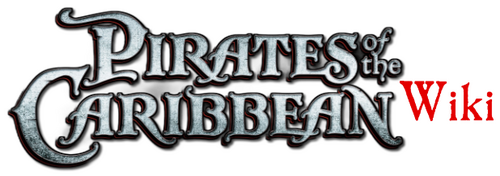Tag: Source edit |
Tag: Source edit |
||
| Line 68: | Line 68: | ||
*The coat of arms on the stern of the ''Silent Mary'' belongs to the Spanish Bourbon dynasty. However, the largest sail on the mainmast is decorated with the double-headed imperial eagle, the symbol of the Holy Roman Empire and the Spanish Habsburg dynasty which went extinct with the death of King Charles II in 1700. |
*The coat of arms on the stern of the ''Silent Mary'' belongs to the Spanish Bourbon dynasty. However, the largest sail on the mainmast is decorated with the double-headed imperial eagle, the symbol of the Holy Roman Empire and the Spanish Habsburg dynasty which went extinct with the death of King Charles II in 1700. |
||
*The young [[Jack Sparrow]] uses the bootleg turn to save the ''[[Black Pearl|Wicked Wench]]'' from the ''[[Silent Mary]]'' and trick the [[Crew of the Silent Mary|Spaniards]] into sailing into the [[Devil's Triangle]]. The name 'bootleg turn' originated during the Prohibition era in the United States, at least two centuries after the events of the film. |
*The young [[Jack Sparrow]] uses the bootleg turn to save the ''[[Black Pearl|Wicked Wench]]'' from the ''[[Silent Mary]]'' and trick the [[Crew of the Silent Mary|Spaniards]] into sailing into the [[Devil's Triangle]]. The name 'bootleg turn' originated during the Prohibition era in the United States, at least two centuries after the events of the film. |
||
| − | *The chronometer used by Carina Smyth is [[Wikipedia:John Harrison|John Harrison]]'s marine chronometer which wasn't designed until 1759, eight years after the events of the film. |
+ | *The [[Codex:C#Chronometer|chronometer]] used by Carina Smyth is [[Wikipedia:John Harrison|John Harrison]]'s marine chronometer which wasn't designed until 1759, eight years after the events of the film. |
*When [[Pierre Kelly]] forces [[Jack Sparrow]] to marry [[Beatrice]], one of the pirates plays [[Wikipedia:Felix Mendelssohn|Felix Mendelssohn]]'s ''Wedding March'' on a makeshift violin. ''Wedding March'' was composed in 1842. |
*When [[Pierre Kelly]] forces [[Jack Sparrow]] to marry [[Beatrice]], one of the pirates plays [[Wikipedia:Felix Mendelssohn|Felix Mendelssohn]]'s ''Wedding March'' on a makeshift violin. ''Wedding March'' was composed in 1842. |
||
*When [[Hector Barbossa]] finds the [[Diary of Galileo Galilei|diary]] of [[Galileo Galilei]] in [[Carina Smyth]]'s possession, he says the book was "''stolen from an Italian ship many years ago.''" Historically, at the time in which the movie is set, Italy was not a unified country. The ancient Roman word ''Italia'' was used to refer to the Italian peninsula, but the peninsula itself was still divided into several separate nation-states, and none of them used the word ''Italy'' in their names. In the same scene Carina explains that she was named after "''the brightest star in the North''". Carina is not a star but a southern constellation that can't be seen in most of the Northern hemisphere. Historically, the constellation was named Carina in 1763 when the French astronomer Nicolas-Louis de Lacaille divided the Argo Navis constellation into three sections, twelve years after the events of the film and thirty-one years after Carina Smyth's birth. |
*When [[Hector Barbossa]] finds the [[Diary of Galileo Galilei|diary]] of [[Galileo Galilei]] in [[Carina Smyth]]'s possession, he says the book was "''stolen from an Italian ship many years ago.''" Historically, at the time in which the movie is set, Italy was not a unified country. The ancient Roman word ''Italia'' was used to refer to the Italian peninsula, but the peninsula itself was still divided into several separate nation-states, and none of them used the word ''Italy'' in their names. In the same scene Carina explains that she was named after "''the brightest star in the North''". Carina is not a star but a southern constellation that can't be seen in most of the Northern hemisphere. Historically, the constellation was named Carina in 1763 when the French astronomer Nicolas-Louis de Lacaille divided the Argo Navis constellation into three sections, twelve years after the events of the film and thirty-one years after Carina Smyth's birth. |
||
Revision as of 19:22, 13 May 2021
Despite being based on the historical time period of the golden age of piracy and featuring several historical individuals and real-world locations, the Pirates of the Caribbean franchise contains many historical inaccuracies. A specific date for the placement of the first three films has not been officially given, but On Stranger Tides was said to be set in the year 1750[1][2] and the official comic book adaptation of Dead Men Tell No Tales shows the film's events are set in 1751. Those two dates and the informations revealed in the tie-in novels set the events of the first three films around 1728/1729.
Movies
The Curse of the Black Pearl
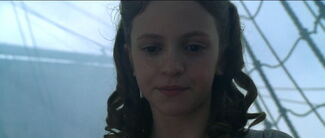
No, it's not okay to say a word from the future!
- When Will Turner wakes up aboard the HMS Dauntless Elizabeth Swann tells him "It's okay!" Historically, the earliest known use of okay in print was in 1839.
- The film depicts Port Royal as a prosperous town and the main British port in the Caribbean in the early 18th century. In real-world history most of the city was destroyed by an earthquake in 1692. Some attempts were made to rebuild the city but these met with mixed success and numerous disasters. The city was largely abandoned in favor of the nearby Kingston which does not appear in the films.
- At least one side of Fort Charles is situated on the edge of a cliff overlooking the sea. The real Fort Charles is located in the middle of the peninsula, far away from the sea.
- Several British merchant ships in the film fly the Union Jack. In real-world history, the use of the Union Jack at sea was limited to military vessels. In 1674 all British merchant vessels were specifically ordered to fly Saint George's Cross or the red flag with Saint George's Cross in the upper left canton, a flag which eventually evolved into the Red Ensign.
- All the Royal Navy officers and sailors are uniformed in the film. Historically, Royal Navy officers and sailors had no established uniforms at the time in which the movie is set. Uniform regulations for naval officers were first issued by Admiral George Anson in 1748.
- During James Norrington's promotion ceremony a band plays "Rule, Britannia!". In real-world history the piece was composed in 1740. The timeline established in the later films sets The Curse of the Black Pearl around 1728.
- Both the HMS Dauntless and the HMS Interceptor fly the Blue Ensign and the blue commissioning pennant, the flags which were historically used by the British Navy vessels patrolling the waters of the south Atlantic, Pacific and Indian oceans.
- Both the HMS Dauntless and the HMS Interceptor are painted in a colour scheme known as the "Nelson Checker" (black and yellow bands with black gun-ports). Historically, even though an Admiralty order in 1715 decreed the use of yellow and black, and a uniform colour within, the order was generally ignored in the Royal Navy. The color scheme only became popular after the Battle of Trafalgar in 1805.
- Jack Sparrow is marked with the P brand. Historically, no such mark was ever used to punish pirates.
- When Jack Sparrow and Will Turner commandeer the Interceptor James Norrington orders his men to load the "Long Nines" to sink the ship. However, the gun showed in the film is actually the carronade. Historically, the carronade was invented in 1774.
- While sailing the Interceptor to Tortuga Jack Sparrow informs Will Turner that his father Bootstrap Bill was "a bloody pirate, a scallywag." Historically, the term scallywag was invented after the American Civil War and referred to white Southerners who collaborated in the Reconstruction.
- The film depicts Tortuga as an active pirate port in the early 18th century. In real-world history Tortuga was a colony of France since the 1620s, even though the port was open to pirates. The Treaty of Ratisbon banned piracy and privateering in Tortuga in 1684. The short comic In Jack We Trust!, which is chronologically set after the events of The Curse of the Black Pearl, shows a governor of Tortuga who threatens to have the disguised British officer James Norrington and his men hanged as spies, implying that the island actually is controlled by some colonial power.
- When Elizabeth Swann discovers that Barbossa's pirates are cursed, Jacoby is seen sitting on the capstan playing a concertina. The concertina was not invented until 1829.
- Before the destruction of the Interceptor Elizabeth and Barbossa use the terms port and starboard to refer to the left and right side of the ship. Historically, it was not until 1844 that larboard was abandoned for port in reference to the left side of the ship.
- Following the destruction of the Interceptor Barbossa maroons Jack Sparrow and Elizabeth Swann on Rumrunner's Isle by making them walk the plank. The phrase 'walking the plank' was first recorded in Francis Grose's Dictionary of the Vulgar Tongue, which was published in 1788. However, the first historical instance of pirates employing the plank occurred in July 1822 when the Spanish pirate crew of the schooner Emanuel forced their prisoner, Captain William Smith of the British sloop Blessing, to walk the plank.
- When Barbossa maroons Jack Sparrow and Elizabeth Swann on Rumrunner's Isle Jack explains that the island was used by the rumrunners as a cache. Historically, the term "rum-running" originated at the start of Prohibition in the United States in 1920.
- Right before Jack Sparrow escapes from Fort Charles by falling into the sea he says "I want you to know that I was rooting for you, mate." to James Norrington. Historically, the expression "root" originated in the United States during the late 1880s.
Dead Man's Chest
- In the film the East India Trading Company does not use any of its historical symbols. All the Company's symbols shown in the film are entirely fictional. The EITC officers wear blue uniforms instead of the historically accurate red uniforms of the Company's private armies.
- The film shows the East India Company spreading its influence to the Caribbean and starting a worldwide war against piracy. Historically, while the EITC naval forces did occasionally assist the Royal Navy in fighting piracy during the 18th century, such actions were limited to the Indian Ocean.
- Like the Royal Navy ships in the first movie, a Royal Navy sloop anchored in Port Royal flies the Blue Ensign instead of the Red Ensign.
- In a deleted scene Will Turner asks Cutler Beckett what is the East India Trading Company doing in the Caribbean, to which Beckett replies "Well, we are East of India. Just the long way around. After all, when goods do not cross borders, then armies will." The 'goods' part comes from "When goods do not cross borders, soldiers will", a quote commonly attributed to the 19th century French economist Frédéric Bastiat.
- Cutler Beckett intends to use the Letters of Marque to recruit Jack Sparrow as a privateer in the employ of England and the East India Company. Historically, the Company could not issue its own Letters of Marque. The Letters had to be obtained from the regular British authorities so the Company's captains and crews could operate as privateers and attack enemy ships in times of war.
- The Edinburgh Trader flies a fictional flag instead of the Red Ensign of the British merchant fleet.
- When Jack Sparrow and Joshamee Gibbs recruit new crewmembers in Tortuga, one of them says "Me have one arm and a bum leg." to which Gibbs replies "It's the crow's nest for you." Historically, the nautical term crow's nest was invented in the early 19th century.
At World's End
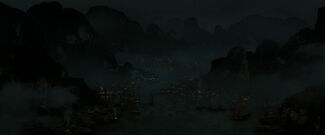
Singapore, a town which shouldn't exist.
- Singapore is depicted as a bustling port town and the headquarters of Sao Feng, the Pirate Lord of the South China Sea. In real-world history, Singapore was founded by Sir Thomas Stamford Bingley Raffles in 1819 on behalf of the East India Trading Company.
- In the beginning of the tea drinking scene with Will Turner, Lord Beckett adds a sugar cube into his tea. The first sugar cubes were invented in the Czech town of Dačice in 1843.
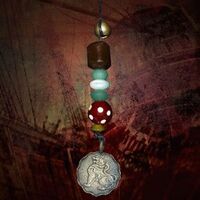
Not so ancient after all.
- According to the "Inside the Brethren Court" featurette from the Pirates of the Caribbean: At World's End DVD Jack Sparrow's piece of eight is an ancient coin from Siam.[3] However, the coin is actually a modern 5 pyas coin from Myanmar (Burma).[4]
- Gentleman Jocard's piece of eight is a pair of tobacco cutters. Historically, the first tobacco cutters were invented in the 19th century, long after the end of the golden age of piracy.
- Joshamee Gibbs explains that "the Pirate King is elected by popular vote". However, the term "popular vote" refers specifically to some modern nation's presidential elections where it is not used to determine who is elected as the nation's president or vice president. With the popular vote the voters first elect an official representative body, which then elects the president. In all other elections, where the leader is elected directly, and especially in the 18th century, the term would be simply "vote".
- After the sinking of the Flying Dutchman Joshamee Gibbs informs Jack Sparrow about the HMS Endeavour approaching the Black Pearl. Jack orders his crew to keep the ship still despite the approaching danger. Hector Barbossa counters Jack's orders by saying "Belay that, or we'll be a sitting duck!" The phrase "sitting duck" was not introduced until the early 1900s.
- When Hector Barbossa commandeers the Black Pearl for the second time at the end of the film, Joshamee Gibbs can be seen seen sleeping with a teddy bear in his arms. Teddy bears weren't invented until 1902.
- Sao Feng's navigational charts show 1523 as the year when Juan Ponce de León sailed for Florida in search for the Fountain of Youth. In real-world history Ponce de León led an expedition to Florida in 1513 and died in 1521.
On Stranger Tides
- The infamous pirate Edward Teach/Blackbeard is the main villain of the film, which is set in 1750. In real-world history Blackbeard was killed during the battle of Ocracoke Inlet in 1718.
- The Queen Anne's Revenge serves as Blackbeard's ship in the film. In real-world history the ship sank in May 1718.
- The film shows the privateer Hector Barbossa in command of a Royal Navy frigate, the HMS Providence. Historically, a privateer captain could command only a privately armed civilian vessel.
- Blackbeard's undead officers are specifically called zombies. In real-world history, the word "Zombie", as "Zombi", first appeared in a history of Brazil by poet Robert Southey in 1819.
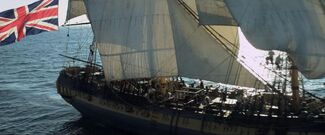
The Providence flies the Union Jack that wasn't designed until 1801.
- The Union Jack used on the HMS Providence has Saint Patrick's Cross, the symbol of Ireland, embedded on it. That version of the flag wasn't designed before the beginning of the 19th century, when the separate kingdoms of Ireland and Great Britain were united into the United Kingdom of Great Britain and Ireland, at least fifty years after the events of On Stranger Tides.
- In the film Hector Barbossa calls the Royal Navy officer Theodore Groves 'Lieutenant Commander'. Historically, the rank was established and first used by the United States Navy in 1862. It was introduced into the Royal Navy in 1914.
- The ships of The Spaniard's fleet fly the war ensign of Spain which wasn't designed until 1785.
- The film shows Juan Ponce de León's caravel, the Santiago, stranded on an unnamed island in the Caribbean with Ponce de León's corpse lying in a bed in the captain's cabin. In real-world history, the Santiago returned to Spain after Ponce de León's expedition to Florida in 1513. Ponce de León was buried in San Juan, Puerto Rico.
Dead Men Tell No Tales
- Gunlocks are visible on the cannons on the Monarch and the Essex. In real-world history, gunlocks were rare since they could only be adapted to new guns, and only became a standard issue in the British Royal Navy around the 1800s, almost fifty years after the events of Dead Men Tell No Tales.
- The film shows Saint Martin as a British colony. Historically, Saint Martin was never controlled by the British. It was a colony of France and Holland since the mid-17th century, while the film is set in the mid-18th century, specifically in 1751.

A telescope from the future?
- When George Swift finds Carina Smyth working with his telescope, he says "No woman has ever handled my Herschel!" William Herschel, the designer of the Herschel telescope, was thirteen years of age at the time in which the film is set, and he did not design the telescope until 1774, twenty-three years after the events of the film.
- When Mullroy and Murtogg go aboard the Queen Anne's Revenge to inform Hector Barbossa about Armando Salazar's return, a group of musicians in the captain's cabin plays the 6th movement of Wolfgang Amadeus Mozart's Divertimento in E♭ major, K. 563. Historically, Mozart wrote the music in 1788, thirty-seven years after the events of the film, and he wasn't even born at the time in which the film takes place. In the same scene a ship model of a clipper can be seen on a table close to the musicians. The first clippers were developed in the early 19th century.
- When Jack Sparrow encounters his Uncle Jack in Saint Martin prison the older pirate sings Maggie Mae. The earliest reference to the song was recorded in 1830, almost eighty years after the events of the film.
- Jack Sparrow is offered to be executed by "a new invention: the guillotine". The comic book adaptation sets the film in 1751. Historically, the guillotine wasn't invented until the 1790s.
- Before he is taken to the guillotine, Jack Sparrow mentions that the French invented mayonnaise. Mayonnaise was said to be invented by the French chef of the Duke de Richelieu in 1756, five years after the events of the film.
- Carina Smyth is condemned to be executed for witchery in 1751. The last such execution in real-world history occurred in 1712, since the executions for witchcraft were replaced by prison sentences due to the growing illumination of that period.
- When the crew of the Dying Gull sails for the Trident of Poseidon, they fly Jack Sparrow's Jolly Roger during the whole journey. Historically, pirates did not fly the Jolly Roger at all times. Like other vessels, pirate ships usually stocked a variety of flags, and would normally fly a false flag or no colours until they had their prey within firing range.
- When Jack Sparrow wakes up in the middle of the night on the Dying Gull he says "Spaghetti wolf!" Historically, the word spaghetti was first used in 1849 as sparghetti in Eliza Acton's Modern Cookery. It comes from Italian spaghetto, which means "string".
- The coat of arms on the stern of the Silent Mary belongs to the Spanish Bourbon dynasty. However, the largest sail on the mainmast is decorated with the double-headed imperial eagle, the symbol of the Holy Roman Empire and the Spanish Habsburg dynasty which went extinct with the death of King Charles II in 1700.
- The young Jack Sparrow uses the bootleg turn to save the Wicked Wench from the Silent Mary and trick the Spaniards into sailing into the Devil's Triangle. The name 'bootleg turn' originated during the Prohibition era in the United States, at least two centuries after the events of the film.
- The chronometer used by Carina Smyth is John Harrison's marine chronometer which wasn't designed until 1759, eight years after the events of the film.
- When Pierre Kelly forces Jack Sparrow to marry Beatrice, one of the pirates plays Felix Mendelssohn's Wedding March on a makeshift violin. Wedding March was composed in 1842.
- When Hector Barbossa finds the diary of Galileo Galilei in Carina Smyth's possession, he says the book was "stolen from an Italian ship many years ago." Historically, at the time in which the movie is set, Italy was not a unified country. The ancient Roman word Italia was used to refer to the Italian peninsula, but the peninsula itself was still divided into several separate nation-states, and none of them used the word Italy in their names. In the same scene Carina explains that she was named after "the brightest star in the North". Carina is not a star but a southern constellation that can't be seen in most of the Northern hemisphere. Historically, the constellation was named Carina in 1763 when the French astronomer Nicolas-Louis de Lacaille divided the Argo Navis constellation into three sections, twelve years after the events of the film and thirty-one years after Carina Smyth's birth.
Books
Jack Sparrow: The Coming Storm
- When Jack Sparrow defeats Captain Torrents with a lightning, he mentions "little Benny" and "that trick" which he showed him "with the kite and the key". Even though that looks like a clear reference to Benjamin Franklin and his experiments with electricity, the timeline established in the film series sets the scene around 1706, a year when Franklin was just a baby.
Jack Sparrow: The Age of Bronze
- In the novel Jack Sparrow and the crew of the Barnacle visit the city of New Orleans. The timeline established in the film series sets the visit around 1706. In real-world history New Orleans was founded in 1718.
- The novel implies the guillotine is well known in France and its overseas ports. In real-world history the guillotine was invented in 1792.
- Jack Sparrow and the crew of the Barnacle encounter Madame Minuit who is disguised as a man wearing a top hat. The top hats did not become common until the end of the 18th century.
Jack Sparrow: Silver
- Laura Smith reveals that the sails of her ship, the La Fleur de la Mort, were woven by the fishermen of Samoa. In real-world history Samoa was discovered by Dutchman Jacob Roggeveen in 1722. The timeline established in the film series sets the events of the novel around 1706.
Jack Sparrow: City of Gold
- The novel implies that grog is already a well known beverage among the sailors. In real-world history grog was introduced by Admiral Edward Vernon in 1740.
The Price of Freedom
- Doña Esmeralda ship, the Venganza, is described as a Blackwall frigate. In real-world history, the first Blackwall frigates were built in the late 1830s.
- The EITC brig the Fair Wind flies the Union Jack instead of the Red Ensign of the British merchant fleet.
- When the Venganza approaches the Fair Wind, the pirates raise the White Ensign, tricking the merchant ship's captain into believing the frigate is a British Royal Navy vessel. Historically, the White Ensign was used by the white squadron which patrolled the coasts of Britain, France and the Mediterranean. The red squadron, which patrolled the Caribbean and the North Atlantic, used the Red Ensign.
- The novel shows the East India Company being engaged in the transatlantic slave trade and having slaving ports and offices on the west coast of Africa. Historically, the East India Company's slave trade was limited to East Africa and the Indian Ocean.
- The time frame references in the novel contradict the historical events. The town of Ribeira Grande on the island of St. Jago (the modern-day town of Cidade Velha) is mentioned to be established by the Portuguese two hundred and fifty years earlier which would set the story around 1712. New Providence is depicted as a pirate-controlled island which would indicate that the story is set before 1718. However, Savannah, which was founded in 1733 in real-world history, is already a well established and prosperous town in the novel. The city of Raleigh also wasn't founded before 1792. In a flashback scene in Chapter Seven Jonathan Beckett Sr. mentions to a young Cutler Beckett that he could purchase him a good commission in the service of the king. However, the timeline established in the films On Stranger Tides and Dead Men Tell No Tales sets the scene around 1705, when Great Britain was ruled by Queen Anne. Ann C. Crispin herself commented that the world of Pirates of the Caribbean is "not our world" but "an alternate universe" where "there are historical events that don’t add up".[5]
Legends of the Brethren Court: Rising in the East
- During a voyage across the Pacific Ocean the Black Pearl arrives to Easter Island which Jack Sparrow also calls Rapa Nui. The name "Easter Island" was given by the island's first recorded European visitor, the Dutch explorer Jacob Roggeveen, who encountered it on Easter Sunday (5 April) in 1722. The timeline established in the film series sets the Black Pearl's visit to the island around 1716. The name Rapa Nui ("Big Rapa"), was historically coined after the slave raids of the early 1860s.
- When Sao Feng asks Jack Sparrow to find the Deep Sea Opal Jack mentions New Zealand as its possible location. Although New Zealand was named Nova Zeelandia by the Dutch explorers in the 17th century, it wasn't until Captain James Cook's 1768 expedition that the name was anglicised into New Zealand.
- After the crossing of the Pacific Hector Barbossa tells Jack Sparrow that New Holland is Australia. The name Australia was only rarely used during the age of discovery, and it was specifically applied to the continent for the first time in 1794 by the botanists George Shaw and Sir James Smith and popularised by the explorer Matthew Flinders in 1804. On Cutler Beckett's world map in Pirates of the Caribbean: Dead Man's Chest, which is set approximately thirteen years after the events of the novel, the historically more accurate name Hollandia Nova can be seen.
- During the attack on Mistress Ching's opium den Benedict Huntington wears a monocle. While the monocle did exist during the early 18th century, it did not become an article of gentlemen's apparel until the 19th century.
Legends of the Brethren Court: Day of the Shadow
- The book reveals the mysterious alchemist Shadow Lord is none other than Henry Morgan, the notorious English privateer and governor of Jamaica. In real-world history Morgan died in Jamaica in 1688. There is also no record of Morgan studying alchemy or doing anything relating to the supernatural.
Comics
The Accidental Pirate!
- When Jack Sparrow and Will Turner board the British merchant vessel Earl King the ship's commanding officer Captain McGlue calls them "officers in the queen's service". Historically, the ruling monarch of Great Britain during that time was King George II. His wife, Caroline of Ansbach, was a queen consort, and held no actual power. All the Royal Navy officers were in the service of the King, not the Queen.
The Guardians of Windward Cove
- In the comic Mutti says Jack Sparrow is no blackbirder, meaning he's not a slave trader. Historically, the word blackbirder was first recorded in 1876, more than a century after the events of the comic.
- Jack Sparrow mentions that he once escaped from Mackie Shackles by using a goat bearing an uncanny resemblance to the governor of Hispaniola. Historically, by that time Hispaniola did not have one governor but two, because the island was divided into two colonies, the French-controlled Saint Dominique and the Spanish-controlled Santo Domingo.
Enter... the Scarecrow!
- Like the Royal Navy ships in the first two movies, the warship HMS Achilles flies the Blue Ensign instead of the Red Ensign.
Video games
Pirates of the Caribbean: The Legend of Jack Sparrow
- At the beginning of the game Jack Sparrow, Will Turner, and the crew of the Black Pearl attack Fort Alvo Grande, a Portuguese fortress in the swamps of Panama. Historically, during the Age of Piracy Panama was firmly controlled by the Spanish. The only Portuguese colony in South America at that time was Brazil. The flag displayed on the fort is not the flag of Portugal but the symbol of the Military Order of Christ.
- Charles Dixon's painting of the HMS Swallow attacking Bartholomew Roberts' flagship the Royal Fortune in the battle of Cape Lopez can be seen on the walls of Carrera de la Vega's cabin on his galleon and inside the Faithful Bride tavern. The painting was made in 1901.
Pirates of the Caribbean: At World's End
- The infamous pirate Bartholomew Roberts is called Black Bart in the game. Even though the nickname "Black Bart" is well known today, it was never used by Roberts nor any of his contemporaries. It was made up by the Welsh poet I.D. Hooson in the twentieth century.
Pirates of the Caribbean Online
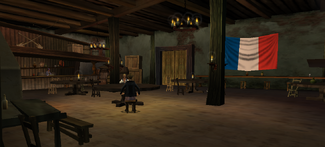
A wrong flag.
- A modern tricolour French flag can be seen displayed on Pierre le Porc's French privateer island stronghold Ile d'Etable de Porc. Historically, the flag was designed in 1790, at least half a century after the events of the game.
Pirates of the Caribbean: Isles of War
- The game shows the pirates using the xebecs in the Caribbean. Historically, that ship type was used only in the waters of the Mediterranean Sea.
Pirates of the Caribbean: Tides of War
- The game shows the pirates still using the carracks and caravels during the War Against Piracy. Historically, both of those ship types were replaced by galleons by the beginning of the 17th century, at least a century before the setting of the game.
See also
Notes and references
- ↑ It was revealed that On Stranger Tides place in 1750. However, the exact time that had passed between At World's End and On Stranger Tides has yet to be revealed. All is known is that it takes place several years after At World's End, according to the film's visual guide: The quest for the Fountain of Youth began several years back after a pirate showdown with the East India Company..
- ↑ "The idea was to take the Pirates of the Caribbean world a few steps beyond, with our new characters engaged in a thrilling and sometimes hilarious search for the fabled Fountain of Youth that takes them from the teaming streets of mid-18th century London to mysterious and dangerous ships and islands inhabited by zombies and mermaids." - Pirates of the Caribbean: On Stranger Tides: The Visual Guide Foreword by Jerry Bruckheimer
- ↑ His Piece of Eight? He acquired the Moroccan beads from a French lady of questionable reputation. And the coin? An ancient coin from Siam, one of the first two bits he ever pirated. The second bit? Well, he bought his hat with that one.
- ↑ 5 pyas coin
- ↑ Becoming Captain Jack Sparrow
